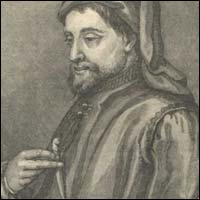
Geoffrey Chaucer (c. 1343 – October 25, 1400) was an English author, poet, philosopher, bureaucrat (courtier), and diplomat. Chaucer is best known as the author of The Canterbury Tales. He is sometimes credited with being the first author to demonstrate the artistic legitimacy of the vernacular English language, rather than French or Latin.
Chaucer was born around 1343 probably in London, although the exact date and location is not known. His father and grandfather were both London wine merchants (vintners) and before that, for several generations, the family were merchants in Ipswich. In 1324 John Chaucer, Geoffrey’s father, was kidnapped by an aunt in the hope of marrying the twelve year-old boy to her daughter; an attempt to keep property in Ipswich. The aunt was imprisoned and the £250 pounds fine levied suggests that the family was well-to-do, upper middle-class if not in the elite. John married Agnes Copton, who in 1349 inherited property including twenty-four shops in London from her uncle, Hamo de Copton, who is described as the “moneyer” at the Tower of London.
There are no details of Chaucer’s early life and education but compared to his near contemporary poets, William Langland and The Pearl Poet, his life is well documented with nearly five hundred written items testifying to his career. The first time he is mentioned is in 1357, in the household accounts of Elizabeth de Burgh, the Countess of Ulster when his father’s connections enabled him to become a page to the noble lady. In 1359, in the early stages of the Hundred Years’ War, Edward III invaded France and Chaucer travelled with Lionel of Antwerp, Elizabeth’s husband, as part of the English army. In 1360, he was captured during the siege of Reims, becoming a prisoner of war. Edward contributed £16 as part of a ransom, and Chaucer was released.
After this Chaucer’s life is uncertain but he seems to have travelled in France, Spain and Flanders, possibly as a messenger and perhaps even going on a pilgrimage to Santiago de Compostela. Around 1366 Chaucer married Philippa (de) Roet, a lady-in-waiting to Edward III’s queen, Philippa of Hainault, and possibly a sister of Katherine Swynford, who later (ca. 1396) became the third wife of Chaucer’s friend and patron, John of Gaunt. It is uncertain as to how many children Chaucer and Philippa had, but 3 or 4 are the numbers most widely agreed upon. Thomas Chaucer had an illustrious career, chief butler to four kings, envoy to France and Speaker of the House of Commons. Thomas’ great-grandson, Geoffrey’s great-great-grandson, John de la Pole, Earl of Lincoln was the heir to the throne designated by Richard III, before he was deposed. Geoffrey’s other children probably included Elizabeth Chaucy, a nun, Agnes, an attendant at Henry IV’s coronation and another son Lewis Chaucer.
Chaucer is presumed to have studied law in the Inner Temple an Inn of Court at about this time, although definite proof is lacking. It is recorded that he became a member of the royal court of Edward III as a valet or esquire on 20 June 1367 a position which could entail any number of jobs. He travelled abroad many times with at least some of them being in his role as a valet. In 1368 he may have attended the wedding of Lionel of Antwerp to Violante, daughter of Galeazzo II Visconti, in Milan. Two literary stars of the era who were in attendance were Jean Froissart and Petrarch. Chaucer also travelled to Picardy the following year as part of a military expedition and visited Genoa and Florence in 1373.
It is on this Italian trip that it is speculated he came into contact with medieval Italian poetry, the forms and stories of which he would use later. While he may have been exposed to manuscripts of these works the trips were not usually long enough to learn sufficient Italian. It may have been his upbringing among the merchants and immigrants in the docklands of London that gave him the opportunity to learn the language. One other trip he went on in 1377 seems shrouded in mystery with records of the time conflicting in details. Later documents suggest it was a mission, along with Jean Froissart, to arrange a marriage between the future Richard II and a French princess, thereby ending the Hundred Years War. If this was the purpose of their trip, they seem to have been unsuccessful as no wedding occurred.
A 19th century depiction of Chaucer. For three near-contemporary portraits of Chaucer see here.Another indication of his early poetic life came on St. George’s Day in 1374 when Edward III granted Chaucer a gallon of wine daily for life for some unspecified service. An unusual grant, Chaucer nonetheless regularly collected it until Richard II came to power and converted it to a monetary grant. A more substantial job was that of Comptroller of the Customs for the port of London which Chaucer began on 8 June 1374. He must have been suited for the role as he continued in it for twelve years; a long time in such a post at that period. His life goes undocumented for much of the next ten years and it is not known if he was in the city at the time of the Peasants’ Revolt. He was mentioned in law papers of 4 May 1380, involved in the raptus of Cecilia Chaumpaigne. What raptus means, rape or possibly kidnapping, is unclear but the incident seems to have been resolved quickly and did not leave a stain on Chaucer’s reputation.
While still working as comptroller Chaucer appears to have moved to Kent, being appointed as one of the commissioners of peace for Kent, at a time when French invasion was a possibility. He also became a Member of Parliament for Kent in 1386. There is no further reference after this date to Philippa, Chaucer’s wife, and she is presumed to have died in 1387. He survived the political upheavals caused by the Lords Appellants and some of the men executed over the affair Chaucer had known well.
On 12 July 1389 Chaucer was appointed the clerk of the king’s works, a sort of foreman organising most of the king’s building project. No major works were begun during his tenure but he did conduct repairs upon Westminster Palace, St. George’s Chapel, Windsor, continue building the wharf at the Tower of London and build the stands at tournament held in 1390. It may have been a difficult job but it paid well; two shillings a day, over three times the salary as a comptroller. In September 1390, records say that he was robbed, and possibly injured, while conducting the business and it was shortly after on 17 June 1391 that he stopped working in this capacity. Almost immediately on 22 June he began as deputy forester in the royal forest of North Petherton, Somerset. This was no sinecure, with maintenance an important part of the job, although there were many opportunities to derive profit.
Soon after the overthrow of his patron Richard II, Chaucer vanished from the historical record. He is believed to have died of unknown causes on 25 October 1400 but there is no firm evidence for this date which is from the engraving on his tomb; built over one hundred years after his death. There is some speculation—most recently in Terry Jones’ book Who Murdered Chaucer? : A Medieval Mystery—that he was murdered by enemies of Richard II or even on the orders of his successor Henry IV. The new king did renew the grants assigned to Chaucer by Richard but in The Complaint of Chaucer to his Purse Chaucer hints that they might not have been paid. The last mention of Chaucer in the historical record is on 5 June 1400 when some monies owing to him were paid. Chaucer was buried in Westminster Abbey in London as was his right owing to the jobs he had performed and the new house he had leased nearby on 24 December 1399. In 1556 his remains were transferred to a more ornate tomb, making Chaucer the first writer interred in the area now known as Poets’ Corner.
Chaucer’s first major work The Book of the Duchess was an elegy for Blanche of Lancaster. Although unlikely that it was commissioned by her husband John of Gaunt, as some scholars have claimed, he did grant Chaucer a £10 annuity on 13 June 1374. Two other early works were Anelida and Arcite and The House of Fame. Chaucer wrote many of his major works in a prolific period while working as customs comptroller. His Parlement of Foules, The Legend of Good Women and Troilus and Criseyde all date from this time. He is best known as the writer of The Canterbury Tales, a collection of stories (told by fictional pilgrims on the road to the cathedral at Canterbury) that would help to shape English literature.
The Canterbury Tales contrasts with other literature of the period in the naturalism of its narrative, the variety of stories the pilgrims tell and the varied characters who are engaged in the pilgrimage which sets it apart from other literature of the period. Many of the stories narrated by the pilgrims seem to fit their individual characters and social standing, although some of the stories seem ill-fitting to their narrators, probably representing the incomplete state of the work. Chaucer drew on real life for his cast of Pilgrims; the inn keeper shares the name of a contemporary keeper of an Inn in southwark, and real life identities for the Wife of Bath, the Merchant, the Man of Law and the Student have been suggested. The many jobs Chaucer held in medieval society; page, soldier, messenger, valet, bureaucrat, foreman and administrator probably exposed him to many of the types of people he depicted in the Tales. He was able to ape their speech, satirise their manners and still offer them popular literature.
Chaucer’s works are sometimes grouped into, first a French period, then an Italian period and finally an English period, with Chaucer being influenced by those countries’ literatures in turn. Certainly Troilus and Criseyde is a middle period work with its reliance on the forms of Italian poetry, little known in England at the time, but to which Chaucer was probably exposed during his frequent trips abroad on court business. In addition, its use of a classical subject and its elaborate, courtly language sets it apart as one of his most complete and well-formed works. In Troilus and Criseyde Chaucer draws heavily on his source, Bocaccio, and on the late Latin philsopher Boethius. However, it is The Canterbury Tales, wherein he focuses on English subjects, with bawdy jokes and respected figures often being undercut with humour, that has cemented his reputation.
Chaucer also translated such important works as Boethius’ Consolation of Philosophy and The Romance of the Rose by Guillaume de Lorris (extended by Jean de Meun). However, while many scholars maintain that Chaucer did indeed translate part of the text of The Romance of the Rose as Roman de la Rose, others claim that this has been effectively disproved. Many of his other works were very loose translations of, or simply based on, works from continental Europe. It is in this role that Chaucer receives some of his earliest critical praise. Eustache Deschamps wrote a ballade on the great translator and called himself a “nettle in Chaucer’s garden of poetry”. In 1385 Thomas Usk made glowing mention of Chaucer, and John Gower, Chaucer’s main poetic rival of the time, also lauded him. This reference was later edited out of Gower’s Confessio Amantis and it has been suggested by some that this was because of ill feeling between them, but it is likely due simply to stylistic concerns.
One other significant work of Chaucer’s is his Treatise on the Astrolabe, possibly for his own son, that describes the form and use of that instrument in detail. Although much of the text may have come from other sources, the treatise indicates that Chaucer was versed in science in addition to his literary talents. Another scientific work discovered in 1952, Equatorie of the Planetis, has similar language and handwriting compared to some considered to be Chaucer’s and it continues many of the ideas from the Astrolabe. The attribution of this work to Chaucer is still uncertain.
Chaucer wrote in continental accentual-syllabic metre, a style which had developed since around the twelth century as an alternative to the alliterative Anglo-Saxon metre. Chaucer is known for metrical innovation, inventing the rhyme royal, and he was one of the first English poets to use the five-stress line, the iambic pentameter, in his work, with only a few anonymous short works using it before him. And the arrangement of these five-stress line into rhyming couplets was first seen in his The Legend of Good Women, was used in much of his later work and became one of the standard poetic forms in English. His early influence as a satirist is also important with the common humorous device, the funny accent of a regional dialect, apparently making its first appearance in The Reeve’s Tale.
The poetry of Chaucer, along with other writers of the era, is credited with helping to standardise the London Dialect of the Middle English language; a combination of Kentish and Midlands dialect. This is probably over-stated with the influence of the court, chancery and bureaucracy—of which Chaucer was a part—remains a more probable influence on the development of Standard English. Modern English is somewhat distanced from the language of Chaucer’s poems due to the effect of the Great Vowel Shift some time after his death. This change in pronunciation of English, still not fully understood, leaves the reading of Chaucer for modern audiences difficult. The status of the final -e in Chaucer’s verse in uncertain; it seems likely during the period of Chaucer’s writing the final -e was dropping out of colloqial English, and that its use was somewhat irregular. Chaucer’s versification suggests that the final -e is sometimes to be vocalised, and sometimes remains silent; however, this remains a point on which there is disagreement. Apart from the irregular spelling much of the vocabulary is recognisable to the modern reader. Chaucer is also recorded in the Oxford English Dictionary as the first author to use many common English words in his writings. These words though were probably frequently used in the language at the time but Chaucer, with his ear for common speech, is the earliest manuscript source. Acceptable, alkali, altercation, amble, angrily, annex, annoyance, approaching, arbitration, armless, army, arrogant, arsenic, arc, artillery and aspect are just some of those from the first letter of the alphabet.
Chaucer’s early popularity is attested by the many poets who imitated his works. John Lydgate was one of earliest imitators who wrote a continuation to the Tales. Later a group of poets including Gavin Douglas, William Dunbar and Robert Henryson were known as the Scottish Chaucerians for their indebtedness to his style. Many of the manuscripts of Chaucer’s works contain material from these admiring poets and the later romantic era poets’ appreciation of Chaucer was coloured by their not knowing which of the works were genuine. It was not until the late 19th century that the official Chaucerian canon, accepted today, was decided upon. One hundred and fifty years after his death, The Canterbury Tales was selected by William Caxton to be one of the first books to be printed in England.
A building has been named in his honour at the United Kingdom Civil Service College.
And much of Chaucer’s work was baudy in the extreme, the Girls Gone Wild level of popularity pornography of its time. Positively filthy. (via Wikipedia)











